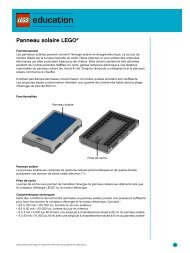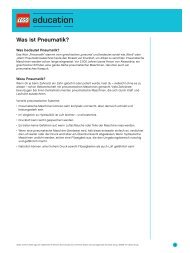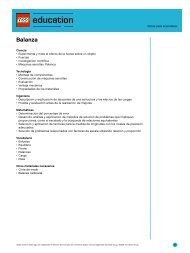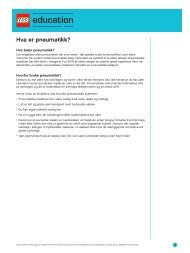Inclined Plane
Inclined Plane
Inclined Plane
You also want an ePaper? Increase the reach of your titles
YUMPU automatically turns print PDFs into web optimized ePapers that Google loves.
<strong>Inclined</strong> <strong>Plane</strong><br />
Student Worksheet<br />
LEGO and the LEGO logo are trademarks of the/sont des marques de commerce de/son marcas registradas de LEGO Group. ©2009 The LEGO Group.
Student Worksheet<br />
Simple Machines: <strong>Inclined</strong> <strong>Plane</strong><br />
An inclined plane is a slanted surface used to raise objects, e.g. a ramp.<br />
Distance<br />
Height<br />
Did you know<br />
The advantage of using<br />
an inclined plane has<br />
been known and used<br />
for thousands of years.<br />
The ancient Egyptians<br />
used inclined planes<br />
made of earth to ease<br />
the transport of their<br />
giant stone blocks to<br />
the top of the pyramids.<br />
Using an inclined plane to raise an object to a given height, the object must be moved a longer<br />
distance, but with less effort needed, than if the object was to be raise straight up.<br />
It’s a trade-off either to use a lot of effort to raise a given load a short distance straight upwards<br />
or to apply much less force to raise it gradually over the longer distance of an inclined plane.<br />
Common examples of inclined planes are ramps, ladders and stairs.<br />
LEGO and the LEGO logo are trademarks of the/sont des marques de commerce de/son marcas registradas de LEGO Group. ©2009 The LEGO Group.<br />
42
Simple Machines: <strong>Inclined</strong> <strong>Plane</strong><br />
Student Worksheet<br />
The mechanical advantage of an inclined plane<br />
The mechanical advantage of an inclined plane describes the relationship between the length of<br />
the slope and the height of the inclined plane.<br />
The mechanical advantage can be calculated using the following formula:<br />
Mechanical advantage<br />
=<br />
Distance load travels<br />
Height load is lifted<br />
D = 3 m<br />
H = 1 m<br />
Mechanical advantage =<br />
3 m<br />
1 m<br />
Mechanical advantage = 3<br />
Calculating the effort needed to raise a known load can be done using this formula:<br />
Did you know<br />
The mechanical<br />
advantage of straight<br />
vertical lift will always<br />
be 1. Meaning you would<br />
have to raise the entire<br />
load without any kind of<br />
mechanical advantage.<br />
Load<br />
Effort<br />
=<br />
Distance<br />
Height<br />
Calculating the effort needed to move a load is also simple in theory. But in practice friction<br />
between the load and the surface of the ramp can affect the effort forces greatly.<br />
LEGO and the LEGO logo are trademarks of the/sont des marques de commerce de/son marcas registradas de LEGO Group. ©2009 The LEGO Group.<br />
43
Simple Machines: <strong>Inclined</strong> <strong>Plane</strong><br />
Student Worksheet<br />
D1<br />
Build D1 book II, pages 2 to 12<br />
Calculate the mechanical advantage. Then let go of the load.<br />
Explain what happens and why.<br />
Load<br />
Effort<br />
D2<br />
Build D2 book II, pages 13 to 15<br />
Calculate the mechanical advantage. Then let go of the load.<br />
Explain what happens and why.<br />
LEGO and the LEGO logo are trademarks of the/sont des marques de commerce de/son marcas registradas de LEGO Group. ©2009 The LEGO Group.<br />
44
















